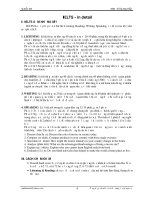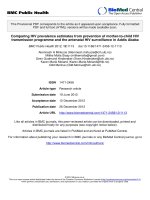congenical rubella syndrome surveillance in combodia
Bạn đang xem bản rút gọn của tài liệu. Xem và tải ngay bản đầy đủ của tài liệu tại đây (1.26 MB, 20 trang )
CONGENITAL RUBELLA SYNDROME
SURVEILLANCE IN
CAMBODIA
(Preliminary results)
Dr.LORN TRY Patrich
General Pediatrician
Kampong-Cham Provincial Hospital,Cambodia
Email:
Dr.LT Patrich,General Pediatrician
INTRODUCTION
• CRS is characterized by multiple defects, particularly to the
brain, heart, eyes and ears congenital heart diseases,
hearing impairment , visual impairment and mental
retardation.
• Treating the illness and disabilities associated with CRS is very
costly.
• Even well treated, many cases may not fully recovered.
• Surveillance of congenital rubella syndrome (CRS) requires a
comprehensive system to detect suspected CRS cases in
infants who present to different health services.
• Most developed countries have established surveillance of
CRS with national disease notification program.
• In developing countries, CRS cases are likely to be under-
reported especially where a high proportion of births occur at
home and neonatal and infant deaths are often unreported.
Dr.LT Patrich,General Pediatrician
INTRODUCTION
• In Cambodia data from EPI and NIPH in 2011: total of 480 lab
confirmed rubella cases
• Around 20% of these cases aged > 15 years some pregnant
women are infected, and their children will be born with
congenital rubella syndrome (CRS).
• As of 2009, 67% of WHO member states have introduced
Rubella vaccines into their routine childhood program.
• In Western Pacific Region, 81% of the 37 member countries
and areas have introduced Rubella Vaccine.
• However, RV has not yet been introduced into Cambodia.
Dr.LT Patrich,General Pediatrician
Objectives of surveillance
• To identify and document the burden of CRS cases in
the two sentinel hospitals : NPH and Kampong-Cham
Provincial Hospital
• To monitor the effectiveness of rubella vaccination
programs.
Dr.LT Patrich,General Pediatrician
• Takeo
METHODS
• Retrospective studies
• Between 1.September 2011 and 30.July 2012 (11
Months)
• Age < 12 Months
• 2 Sentinels sides : NPH and Kg. Cham hospital
Dr.LT Patrich,General Pediatrician
Inclusion criteria
• Detects at least : Two of the complications listed in (A) OR
One in (A) and one in (B):
A. B.
– Congenital heart disease - Purpura
– Cataract(s) - Splenomegaly
– Hearing impairment - Microcephaly
– Congenital glaucoma - Developmental delay
– Pigmentary retinopathy - Meningoencephalitis
- Radiolucent bone disease
- Jaundice within 24 hours
after birth
Dr.LT Patrich,General Pediatrician
Key data to be collected
in the investigation form
• Infant’s identification
• Patient's date of birth, Sex, name of parents,
address, phone number of parents
• Date of notification, name and phone
number of notificator/investigator
• Date of investigation
• Clinical signs and symptoms
• Maternal history : age, febrile rash illness or
exposure to febrile rash illness during this pregnancy,
vaccine history
Dr.LT Patrich,General Pediatrician
Dr.LT Patrich,General Pediatrician
• Six months, We have Identified 20
suspected cases of CRS (NPH=9, Kg-Cham
Hospital=11) using WHO recommended
case definition (inclusion criteria)
Dr.LT Patrich,General Pediatrician
RESULTS, SEX (6 M)
[N
0
= 19 ( NPH= 9, Kg-Cham= 11]
Dr.LT Patrich,General Pediatrician
Age ( N
0
= 20)
Dr.LT Patrich,General Pediatrician
BIRTH WEIGH ( N
0
=20)
Birth weigh
Percentage
< 1500 g
1 (5%)
1500 – 2000 g
9 (45%)
> 2000 – 2500 g
9 (45%)
> 2500 g
1 (5% )
Total
20
Dr.LT Patrich,General Pediatrician
CLINICAL SIGNS ( N
0
= 20)
CHD
15 (75%)
Cataract
12 (60%)
Purpura
9 (45% )
Jaundice
6 (30%)
Splenomegaly
2 (10%)
Dr.LT Patrich,General Pediatrician
RISK FACTOR ( N
0
= 20)
Mother has rash illness during pregnancy
18(90%)
First trimester
15(75%)
Expose during pregnancy
9 (45%)
Dr.LT Patrich,General Pediatrician
Dr.LT Patrich,General Pediatrician
Dr.LT Patrich,General Pediatrician
Conclusion
• CRS is a major public health problems in Cambodia
• 20 CRS cases are identified during a 6 month period
from Sept. 2011 to Feb. 2012.
• Most frequent Congenital heart disease(75%) and
Cataract (60%)
• Most frequent Mother has rash illness during
pregnancy in first trimester (90%)
• Hearing loss present at birth is often not detected until
a later age.
• Should EPI consider Introduction of Rubella Vaccine
into Cambodia?
Dr.LT Patrich,General Pediatrician
ACKOWLEDGEMENT
1. Prof.EAP Tek CHHENG Ex.President Cambodian pediatric
association (CPA)
2. Dr. Houng Vuthy Ex Member of council CPA
3. Dr.Hav Rathneary EX Member of Council CPA
4. Dr.Chham Samnang EX Member of Council CPA
5. Assis.Pro.Sao sokun wathna National Pediatric Hospital
6. Dr.Phe Chan Sokhamony Kampong-Cham provincial
Hospital.
7. Dr.RICHARD JOHN WILLIAM (CAM) WHO
Dr.LT Patrich,General Pediatrician
REFERENCES
1. BMC Infectious Diseases, Congenital rubella syndrome in Iran
, 2005, BMC Infectious Diseases 2005, 5:44 doi:10.1186/1471-2334-5-44
2. BMC Public Health 2009, 9:269, Rubella seroprevalence among primary
and pre- primary school pupils at Moi's Bridge location, Uasin Gishu
District, Kenya, BioMed Central, BMC Public Health 2009, 9:269
doi:10.1186/1471-2458-9-269
3. Berger et al. BMC Public Health 2011, 11:340, Congenital rubella
syndrome and autism,spectrum disorder prevented by rubella,
vaccination - United States, 2001-2010.
4. Ortega García et al. Prenatal exposure of a girl with autism spectrum
disorder to ‘horsetail’ (Equisetum arvense) herbal remedy and alcohol: a
case report Journal of Medical Case Reports 2011, 5:129.
5. Guidelines for surveillance of congenital rubella syndrome and rubella
Field test version, May 1999, DEPARTMENT OF VACCINES AND
BIOLOGICALS, World Health Organization, Geneva 1999
(www.who.int/gpv-documents)
Dr.LT Patrich,General Pediatrician









